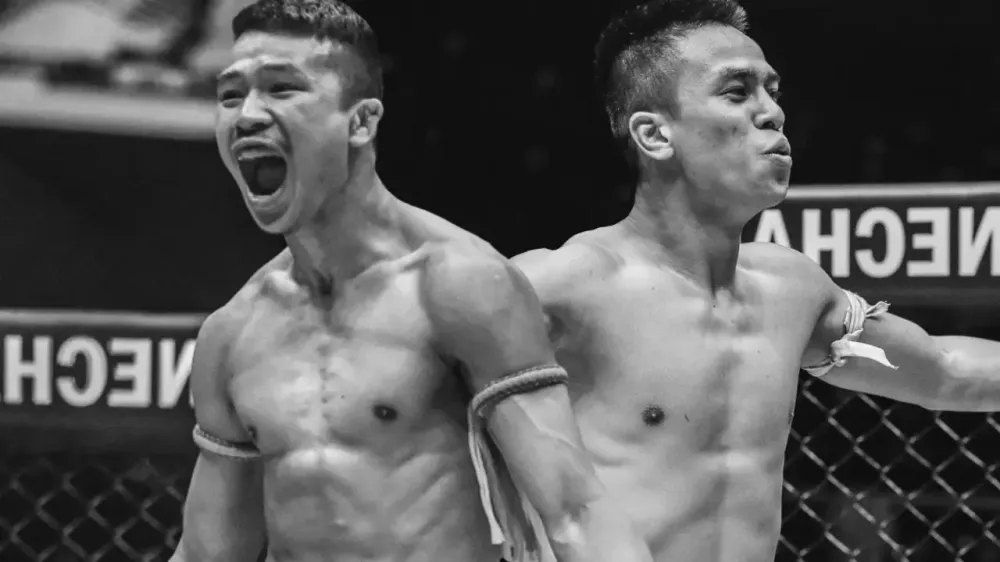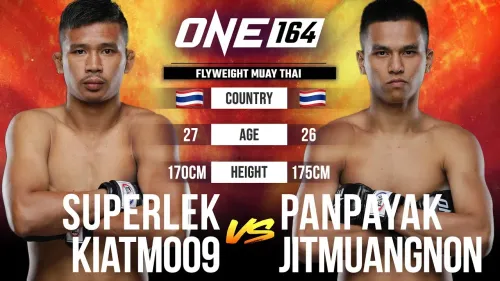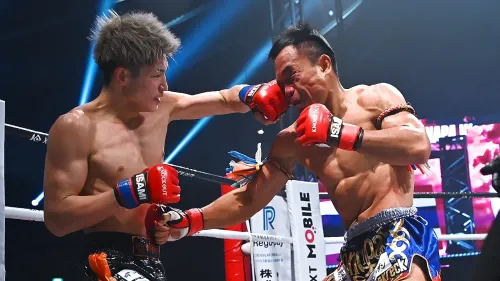Following ONE Championship’s Flyweight Muay Thai GP has been a bumpy road. Fans have seen some fantastic and memorable performances, but also suffered the heartbreaking loss of many of the originally scheduled fights. The reigning champion Rodtang bowed out, fan favourite Haggerty never made it in, and one side of this deciding bout wasn’t even part of the original lineup. Such is life. For better or for worse though, the final is almost here: the eighth fight in a long-running rivalry between two giants of modern Muay Thai. It’s hard to be disappointed.

As fighters, Superlek Kiatmoo9 and Panpayak Jitmuangnon have a striking amount in common. Together they have a long rivalry, having emerged at the bleeding edge of a talented new generation of Muay Thai fighters in the 2010’s. Both began competing as pre-teens, won their first top stadium title more than ten years ago, and have fought at the elite level for what is now well over a hundred fights each. As contemporaries, they have captured the most prestigious belts in Thailand in multiple weight divisions, and both have won the supremely coveted 'Fighter of the Year' award (Panpayak in fact is the only fighter in history to ever win three years in a row). Without question, they are two of the best and most successful Thai fighters (Nak Muay) of the modern era.
They also fall neatly into the same category within the sport’s fuzzily defined array of fighter archetypes. They are technicians, both specializing in fighting at long range with a body kick that is both ferocious and versatile. A long career nevertheless demands having many options available. Among other things they are also hard, accurate punchers, and elite clinchers: Superlek beat a clinch specialist at his own game to add another championship belt to his collection in 2022. Skill for skill, they are hard to separate; what contrast more easily are their physical proportions, individual bearings and approach to fighting.
Weapons of Choice
Panpayak is the taller and longer-limbed of the two. He is remarkably poised and light on his feet, seeming to have the knack for remaining completely loose at every possible moment. His attacks are fluid and mechanically impressive, full-body torque accelerating his striking limbs to the point they practically crack like whips. For the most part he is known for his teep and his left kick. His legs are so long that he could probably teep his opponents from the stadium car park, and he famously used his left kick to usurp the great Sam A with a stunning knockout. His lead hand is also a constant fixture of his fights, especially in small gloves: he will sting people with counter jabs, interrupt them with a retreating jab when pressed, and flick it out for a momentary distraction while he repositions his feet for a thunderous left kick. Though not a combination puncher his right hook and left straight are crisp and accurate (he has knockdowns with both hands in ONE), and he regularly plugs opponents with a long left straight to the body.
Most of Panpayak’s international fights have been characterized by his retreating footwork. Fighting Kudo in 2019 and Puertas in 2021 he slid out of range of incoming strikes and punished them with his lead hand, rear straight and body kick. His boxing defense though is grounded in his distance management and his clinch, and he has been caught and KO’d by big punchers before. Puertas was eventually able to trap him on the fence and do good work with body-head punch combinations. Not long after this Panpayak made a move to Evolve gym in early 2022, and in the time since he has posted to social media about a specific focus on forward pressure and ring control. In his August meeting with the unlucky Savvas Michael, he was noticeably more aggressive, holding the centre ring and firing first.
By contrast to Panpayak, Superlek appears to be a more compact and forceful fighter. Where Panpayak glides, Superlek stalks, tracking his opponents with a kind of steady intensity. His strikes don’t resemble whips so much as concussive thuds – they seem to appear without warning, as though driven directly outwards from his core on pistons.
As anyone familiar with Superlek will know, his primary weapon is his right leg. Both extremely powerful and extremely hard to read, it sometimes seems like a one-size-fits-all solution to anything his opponents might try. He has fought for a long time as an evasive, mobile fighter; much like Panpayak he can counter-kick extremely well on the back foot. The older Superlek of today though is a firmly rooted powerhouse. His battering ram of a right leg will win him trades with just about anything his opponents might line him up with, breaking balance and killing counters before they can be launched.
Besides his kicks, his punches are neat and powerful. He’s more of a puncher than a boxer – by which I mean that his punches might be long, tightly thrown and heavy, but he does lack some of the boxer’s ancillary skills. He can sometimes be seen leaving his feet behind and leaning forward when power punching and his stance is always upright (fifteen years of winning fights with the right kick will do that). Regardless, his long right straight and left hook effectively complement the threats posed by his primary weapons. He often uses his kicks to set up stepping knees, and has recently had phenomenal success in ONE with his elbows – icing Goncalves in the semi-final with an intercepting lead elbow, and pushing the tough Naito to the cage before nailing him to the wall in the tournament opener.
A Seven-Year Rivalry
Of the extensive existing rivalry between these two men, four fights are available on YouTube. Their stadium fights share a lot of common threads and they are decided by a combination of the kicking battle and the clinch. The clinch in particular has been decisive more than once, and the two men have traded wins and losses here, but ONE breaks clinches very quickly so this is unlikely to be a big factor in their upcoming fight.
Expect instead that two of the best kickers on the planet will be performing another live seminar. These fighters kick in such a way that they can stop an advancing opponent on the spot and break down a blocking arm, so to deal with each other they raise shin checks almost to their shoulder in a fraction of a second. Both men have excellent eyes and will pick off any attack that isn’t very carefully chosen or disguised, so in order to beat the block they disguise their timing with rhythmic swaying and sudden off-rhythm attacks. Typical tactics include firing kicks in twos and threes, baiting the check too early with fakes, and firing the kick high over the block to strike the arm by the wrist and shoulder.
Punches are less incentivised in Muay Thai scoring and so both typically use them more to set up the kicks or score a quick counter than anything else, though they make good use of the rear straight to the body. In the fights which are available Superlek generally took the front foot, pressuring his longer and faster opponent into clinch exchanges on the ropes, and used a step up left knee off his right kick to score past Panpayak’s defense. Despite his efforts though he usually came up short of the win – he lost four of six stadium fights to Panpayak, including three in a row before they each found their way into ONE.
ONE Championship Clash
The most recent fight of the series was the only one contested over 3 rounds in 4oz gloves, and Panpayak was the likely favorite. Despite a couple of KO losses and fighting less often than he had, he was still the most successful fighter of his generation and still showed no signs of being an easy night for anyone. His speed, his reach, his sharp and accurate boxing: beating him in 4oz gloves and without the clinch seemed like a tough ask, even for a fighter as exceptional as Superlek. The Kiatmoo9 team needed to come up with a fresh approach if they were to have an answer.
Come fight night, Superlek entered the ring seemingly armed with two simple ideas:
- He would chase after as many of Panpayak’s successful attacks as he could, countering in combination and extending exchanges rather than relying on winning them quickly.
- Panpayak’s focus, expectations, and muscle memory would all be primed to defend Superlek’s right body kick. He could find more success by sending his right kicks low to the inside thigh instead.
Both ideas were winners. Right from the bell Superlek took the front foot and the initiative, and he punished Panpayak’s lead leg at every opportunity he got during the first round.
Despite fighting hard Panpayak had dropped R1 and sustained what must have been considerable attritive damage to his leg – with only three rounds to work, he knew he had a narrow window to correct the course of the fight. Before the end of R1 he was already throwing good counters, and by R2 he was ready to punish these leg attacks consistently. It took Panpayak barely three minutes to find a way to dissuade Superlek from his success, and he did so with consistent counters from his main backside weapons (the left straight and kick).
Superlek’s inside low kicks left him vulnerable in two ways: using his back leg it squared him up, presenting a bigger target for Pan’s counter; also, after absorbing the kick, Panpayak’s leg was knocked sideways into a square stance from which his own powerful rear side attacks were easily launched. In the first 15 seconds of round 2 Superlek attacked the inside leg twice and was immediately countered both times. Consequently Superlek mostly abandoned the kick, only throwing it if he led with a different attack and had Panpayak giving ground.
From then on the fight became far more of a classic open side body kick battle, and the pace gradually slackened as both fighters found themselves eating hard kicks to the midsection in response to most boxing entries. The fight had been a close contest throughout and at this point both men fell back into their familiar stadium tactics. Just before the final bell, Superlek ended a tight third round by sneaking in a clean counter kick under Panpayak’s cross, and then it was all over. The judges had it a Superlek victory.
Score to date: 4-2-1 Panpayak.
The Hateful Eight
In many ways the story of the eighth fight is already written. Panpayak and Superlek have now spent ninety-nine minutes in the ring together and their default dynamic is set – with fight 7 in the balance during the third round, they fell back into much the same tricky kicking battle they’ve had many times before. A few wrinkles do exist though, and I think it’s worthwhile discussing what they might mean for the battle for the flyweight grand prix.
Firstly, fights in ONE are not scored the same way as Thai stadium bouts. The organisation places a greater emphasis on punches to the head, damage (visible or assumed), and aggression. At the time of their first fight in ONE both fighters had competed in the promotion twice, but were still taking most of their fights on other shows, and their early ONE opponents were frankly way out of their depth. The upcoming fight will be the third consecutive ONE fight for both men, a GP belt and presumably title shot against Rodtang are on the line, and ONE’s prestige in the Muay Thai world has grown considerably – the upcoming fight will have the full attention of both camps. Indeed, there’s reason to think that both men have adapted their approach somewhat for international waters – Superlek’s low kick and forward pressure are constant features of his recent fights, and Panpayak’s new team at Evolve (a gym closely tied to ONE’s promotion) have claimed to have remoulded him into a similarly aggressive front foot fighter.
The implications of forward movement and aggression follow right into our second wrinkle – the cage. None of the seven existing fights between these two have taken place in the cage. Don’t be fooled by the lack of corners – the cage wall is a much more dangerous place to be than the ring ropes. In a ring, a fighter can extend their back foot under the bottom rope to keep a strong stance and lean into the flexible boundary to evade and block. The cage however is unyielding. Caught flat against it a fighter has nowhere to go, and with their back foot stuck directly underneath them they have no solid stance from which to counterattack either. Getting stuck on the fence even for brief moments, in a fight as competitive as this one, could be fatal.
Both fighters probably know this. Panpayak found his usual defensive moves lacking when faced with the determined and effective pressure of Daniel Puertas, and Superlek found his decisive lead over Taiki Naito by pinning him against the fence. My take is that Superlek is a more natural front-foot fighter than Panpayak and is more likely to apply the pressure. He certainly has the tools to cut off an opponent, though whether he can trap someone as slick as Panpayak in a big round cage is uncertain.
However things do turn out on the night, we’re sure to see some of the highest level Muay Thai possible today. Fans of the art shouldn’t miss this one. While you enjoy it, spare a thought for Rodtang – his next fight will be with the winner, and his championship reign has never yet been in so much danger.







